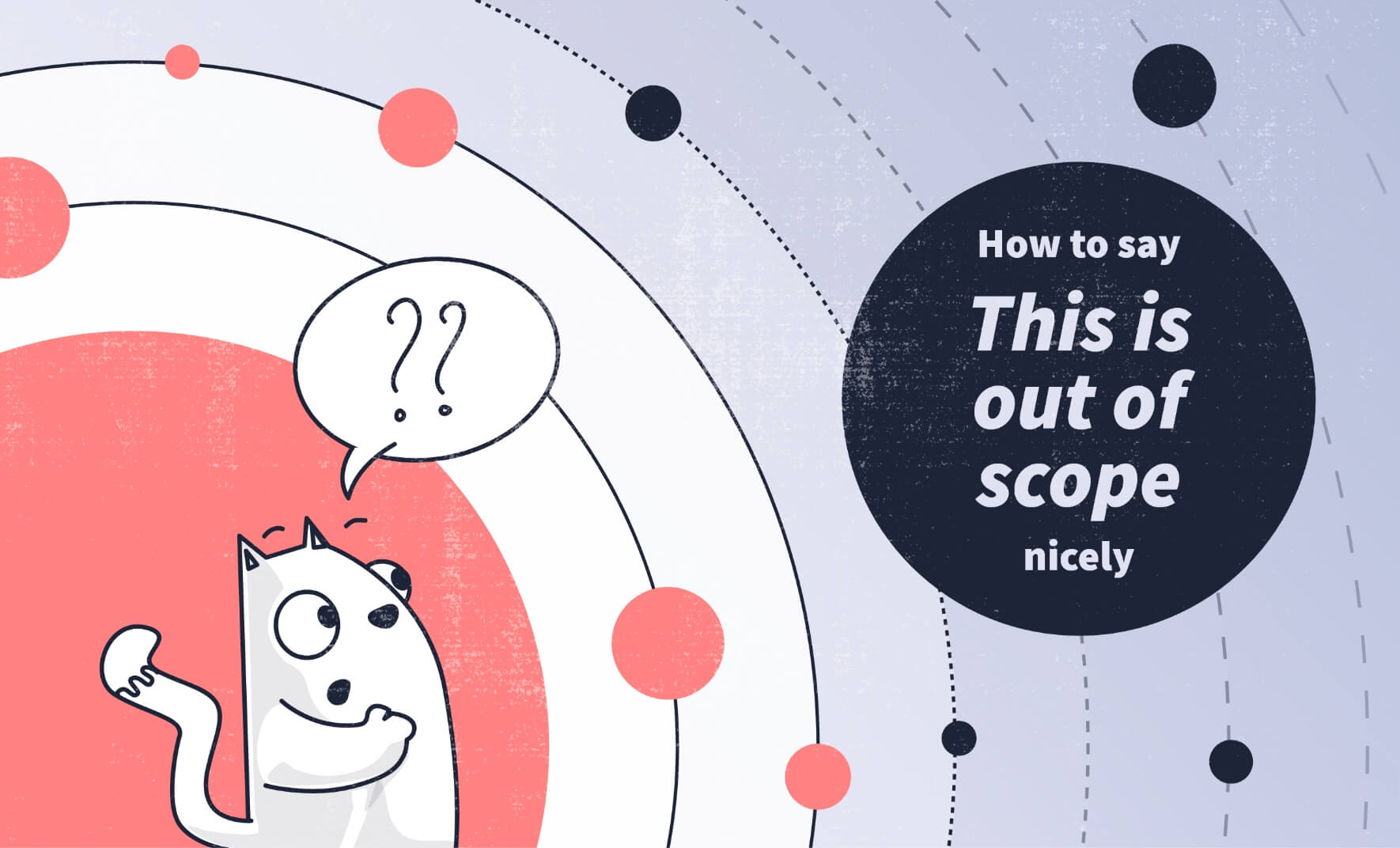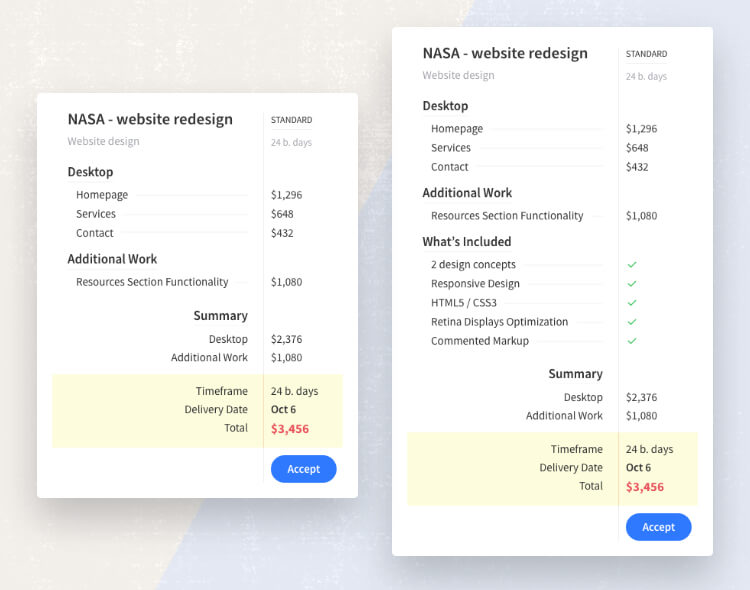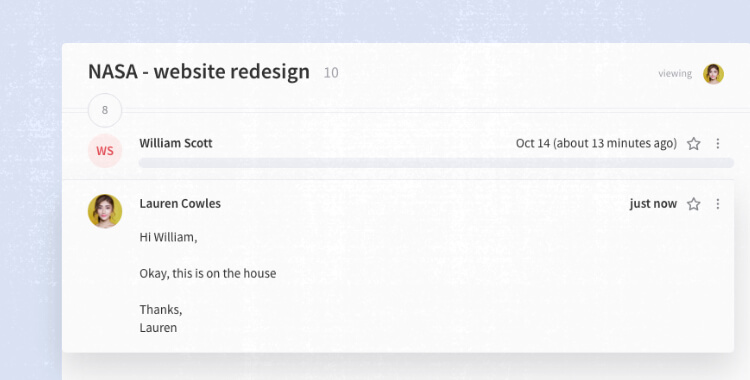How to tell a client “this is out of scope”, nicely

Sometimes, some of you charge your clients by the hour (hourly rates). Great, so time is important, save some and skip this article. You shouldn’t have a problem with going out of scope or the dreaded scope creep!!
However, many of you charge per project (flat pricing fee). For you people out there, freelancers or agencies read on, and read carefully, because chances are you either don’t get paid for out of scope features/updates or your clients are pretty frustrated when they realize they have to pay extra.
Let’s pretend you’re the client, you’ve ordered a project, they delivered, but you want something changed. You are no expert but it looks like a pretty quick update (but you probably didn’t give this instruction upfront) and you’re told that this costs extra, because it was not included in the initial scope you’ve been given. And by extra I mean, like 20% of the total cost of the project. Shocker!
Okay, you bite your tongue and agree. Later on, you request another similar small/tiny/micro update, it’s nothing really (at least according to you), and again you get a response that this will cost another extra 20% onto the project and you’re now like 40% above the initial price estimate. The frustration is now anger, you agree that this may be a little out of scope, but it’s now way above your budget as well.
This is exactly what your clients think every time they request an out of scope update. For them it’s like adding an extra topping to the pizza, they know they have to pay but it’s only an extra bit so why is it such a big deal? You know different.
So here is how you can do it nicely, politely, calmly, and without upsetting, or infuriating your clients. So much better for both sides, I’m sure you’ll agree.
1. Clear up all details before giving the price
Ideally, before you give the price all the details are covered, clear and the client will know exactly what is and isn’t included in the quote. Problem solved, no out of scope issues, it’s all there in black and white… you think.
We all know this seems obvious and an easy solution doesn’t always work out. Even the best projects change and adapt along the way, clients come up with new ideas, see inspirational sites, and decide they want something else included, the potential for change is always there. Did the client fully understand or even read the full quote, or did they just look at the final figure?
And it isn’t just the clients, it’s tempting to lower the quote when chasing a project. Do you include absolutely everything down to the finest detail, you’re trying to undercut your competitors and you’re trying to get the quote away as quickly as possible, and you’ve got other projects on the go… and you’ve got other projects to quote for,… and what about that lunch meeting, and you need to check on… etc, etc.
Detail and clarity upfront, full and comprehensive quotes will save you hassles later which leads us to….
2. Give a detailed price breakdown

As above, ideally, a detailed price breakdown will cover most of the bases and solve problems before they start.
But it is inevitable that issues will arise, (often like a Zombie apocalypse). What a detailed price breakdown does, is it helps you explain to the client exactly what is included in the original quote and exactly why this new request is out of scope. You can point out what was requested, you can demonstrate and explain what was charged for and it should be clear how this new request doesn’t fit in with the original scope.
Check out the different price breakdowns below. One leaves lots of room for misinterpretation and argument the other is very clear and well-defined.
3. Explain nicely that this isn’t a 10 min update
Be fair, your client is unlikely to be an expert in your field. It’s not unusual for them to request something they see as a quick and easy addition or change and not expect it to start World War III.
If you asked for a little more milk in your coffee it’s no big deal right, but if you ask for your cappuccino to be black – then you need to start again. You need to take the time and make the effort to explain why the request is not just a quick fix. Why it will take more time, why it will cost more money, be professional, suggest options that could be cheaper or compromises. Show that you can work together rather than being seen as someone adding extras to increase your cut. These are the things that can build long term business relationships, and in these situations out of scope can be a great way of cementing partnerships.
4. 10 min update? Do it for free and get the credit for it

Sometimes the out of scope updates really are just simple changes and can be done quickly and easily without pushing the timeframe or adding significant labor costs.
A 10-minute freebie costs you little but can reward you 10 fold. Returning clients, recommendations, testimonials at the end of the project. This is an investment for your business, not a completely free gift. It shows good grace, a willingness to help out, a way to demonstrate your quality and professionalism over the bottom line.
Think of it as the free fridge magnet given to you in a shop, a gift – yes but also a constant reminder of that shop, a great advert. It’s the free car wash when they’ve serviced your car, it’s the gratis whiskey at the end of a fine meal – it leaves them feeling satisfied, they’ve got a bonus, they are special, they will return.
5. Clarify the agreed work
Make sure the client understands that the agreed figure is for the agreed work. It’s understandable that the figure that comes at the end of the quote is the figure you think you should be paying. A client wants to have a concrete figure to budget around, even to quote to their bosses or decision-makers higher up the ladder.
Once the client agrees to the quote, point out that this figure covers everything within the agreed project scope. You may think it’s obvious, you may even have discussed it previously but add a note, put it in an email – make sure they know it. Anything out of scope is seen as additional. Frustration often comes from misunderstandings and miscommunications, copies of an email like this can be referred to in any disagreement.
If I have builders working on my house I want to know, the overall price for the work, job done, complete. I don’t want them to start adding an extra bag of cement, and sand because I’ve agreed that the materials are included in the price. If I ask them to add an extra room, I’d expect to pay for more materials plus labor, it’s obvious but we sit down and talk about it. Why would your projects be any different?
6. Tell them before – this is “out of scope”!
Communication of work that is out of scope needs to be done before you start the work. It is no surprise that clients get frustrated when they are charged extra for something they took to be part of the deal. If I expect my hotel wi-fi to be free because that’s standard and suddenly it’s been added to the bill in the morning, I am not going to be a happy. Will I complain – yes, will I kick up a fuss – yes, will I leave a negative review – yes, will I pay up – probably, will I return – no way, will I advise friends and colleagues to stay there – not a chance.
It’s understandable that you want to get on and an additional request, change, or update can often delay the project until you’ve got confirmation but the stress caused for both parties in the event of misunderstandings is considerable and can completely ruin a project and put pay to any future dealings.
Communicate on request, not on completion.
Closing words
Business is business, clients will always want more bang for their buck – it’s part of the game. In some cultures, it really is a game and they get upset when you don’t play. They may push you for more than you agreed, you may give a little, give too much and they’ll push for more, give way too much and you’ll lose all respect (and profit)
The key here, as with most business dealings is clear, solid, detailed communication. When in doubt – ask, when you think they may be in doubt – inform…thinking they understand is not enough, be sure. An extra message of clarification can save stress for both parties, explanation saves exclamation.